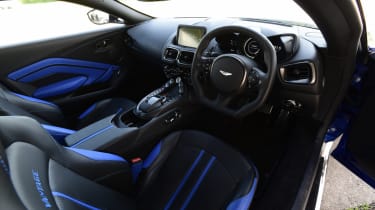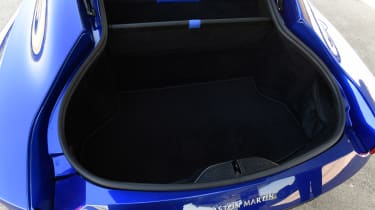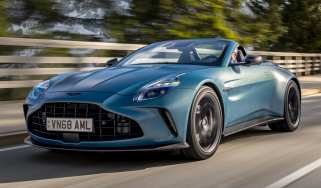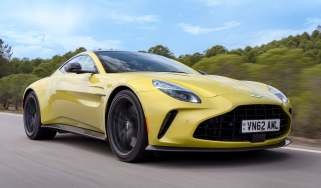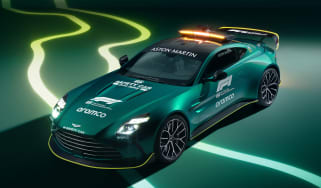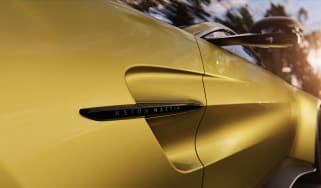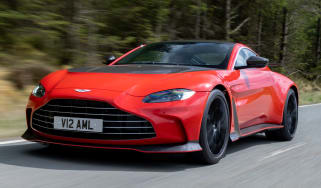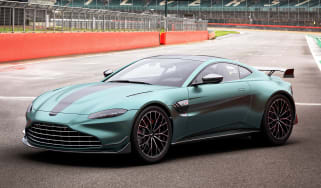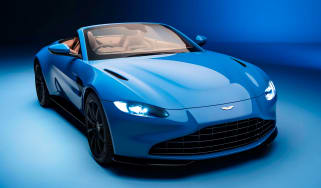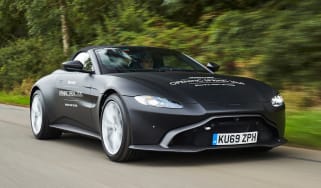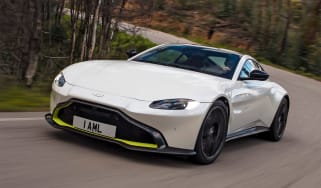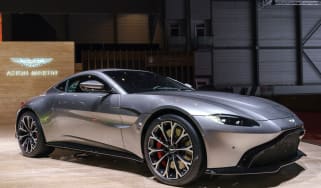Aston Martin Vantage review
The Aston Martin Vantage blends modern styling with a Mercedes-AMG V8 and is one of the most appealing cars in its class

The previous incarnation of the Aston Martin Vantage was an extraordinarily popular car for the British company and, in that respect, this model should carry on where the previous one left off. The old Vantage was really feeling its age, but the new Vantage addresses all of its predecessor’s issues so it can compete with class-leaders such as the Porsche 911 and the Audi R8.
Today’s Vantage features a modern, potent V8 from Mercedes-AMG, which offers stunning performance while retaining the traditional Aston Martin character and charm. Combine this with a depth of dynamic ability and remarkable refinement, as well as a classy cabin and modern infotainment, and it’s easy to see why the new Vantage should be a real winner for Aston Martin.
It can be tough being a small, bespoke manufacturer in a world where ever-increasing development costs make bringing new models to market an eye-wateringly expensive business. And for many years Aston Martin struggled to launch new cars – the previous Vantage was in production for 13 years, which is almost unheard of these days, when mainstream manufacturers replace their core models far more frequently.
But the new Aston Martin Vantage spearheads the revival of the company, and a flurry of new models has seen it rising back to the top of the pack. Aston’s first new model in this new wave was the sublime DB11 and the Vantage builds on its good points, but at a more attractive price point. That puts it up against rivals such as the Porsche 911, Audi R8, Mercedes-AMG GT and Jaguar’s F-Type SVR.
Used - available now

2023 Aston Martin
Vantage
14,000 milesAutomaticPetrol4.0L
Cash £95,990
2023 Aston Martin
Vantage
11,414 milesAutomaticPetrol4.0L
Cash £115,000At just over £120,000 before you’ve plundered the extensive options list, the Aston Martin Vantage needs to be good, because its rivals are all interesting and entertaining choices. But the good news is that it is a very good all-rounder, with a breadth of talent that arguably isn’t matched in this class. Perhaps the Porsche 911 is ultimately a sharper car to drive, while the Mercedes-AMG GT has a more thunderous soundtrack, but there’s plenty to like about Aston’s new entry-level model.
The company has made the bold move of sourcing the Vantage’s engine from Mercedes-AMG, so the car has the familiar 4.0-litre twin-turbo V8 that develops 503bhp and 685Nm of torque – which is good enough for a sub-four second 0-62mph time and a top speed of 195mph.
It's never just about the numbers, though; a car in this class needs to deliver its performance in a thrilling way – and the Vantage doesn’t disappoint. Switching between its three driving modes changes it from cruiser to finely honed sports car and, unlike some of its competitors, it’s also surprisingly refined with an unexpectedly comfortable ride.
It’s strictly a two-seater, though, which does make it a little less practical than some of its rivals with 2+2 seating. But the interior is well appointed, with swathes of leather and a infotainment system (also from Mercedes) that’s streets ahead of what used to be the norm in Aston Martins. It’s perhaps not as cutting-edge as what you’ll find in the latest Porsche or Audi, but it’s easy to operate and works very well. The car’s 350-litre boot is also a plus for this class of car – many of the Vantage’s rivals offer far less luggage carrying capacity.
Ultimately, the Aston Martin Vantage is a huge step up from the model that went before it. Its performance and refinement are exceptional, and for those looking for a brilliantly well rounded sports coupe it has very few peers indeed.
Engines, performance and drive
Developing a range of engines from scratch is hugely expensive, especially when faced with increasingly tough and demanding emission levels. As a result, Aston Martin has sourced the Vantage’s engine from Mercedes-AMG. Under the car’s shapely bonnet you’ll find a twin-turbocharged 4.0-litre AMG V8 that develops 503bhp and the Vantage retains a traditional rear-wheel-drive approach, unlike many of its rivals, which have all-wheel drive.
Aston’s engineers have tweaked the engine to give it a character more in line with what’s expected of the British brand, and it’s mated to an eight-speed automatic transmission. There are three driving modes – Sport, Sport+ and Track – and these settings have a direct effect on the engine, gearbox, steering and adaptive dampers. The Vantage’s suspension set-up follows that of the DB11, with double wishbones at the front and a multi-link system at the rear, and power is transmitted to the road via an electronically controlled limited-slip differential.
So, the new Aston Martin Vantage has all the basic ingredients in its arsenal, but how does it drive? In short, very well, indeed. The default driving mode is Sport – the most comfort-orientated of the three – and this makes the Vantage remarkably cultured for a 500bhp sports car. The ride exhibits a welcome comfort even on pockmarked roads, while the slick eight-speed box shuffles through its ratios pretty seamlessly.
The Vantage really comes alive when you select Sport+ or Track mode, though, with a more strident tone from the engine and its responses more finely honed. The steering is well weighted and accurate and, while it might not give as much quite feel and feedback as a Porsche 911, it’s much better than most of its rivals. Despite only having rear-wheel drive the Vantage transmits its power to the road very effectively and rarely scrabbles for grip. Turn the traction control fully off and the Vantage will drift very effectively, with a beautifully composed action controlled by your right foot and the steering. Overall, the Vantage really is a superb driver’s car.
Engines, 0-60 acceleration and top speed
Despite being smaller than the V8 engine in the old Vantage, the Mercedes-AMG sourced V8 in this car more than makes up for it with the addition of a brace of turbochargers. It develops 503bhp and 685Nm of torque, which is more than enough for most situations, and capable of rocketing the Vantage from 0-62mph in just 3.7 seconds before reaching a maximum speed of 195mph.
Aston Martin has tweaked the engine to give a more quintessentially Aston noise. However, while it certainly sounds different to the same engine in Mercedes-AMG vehicles, it is relatively subdued, lacking that characteristic snarl to which we’re accustomed. It really comes alive higher up the rev range, though, and will undoubtedly be loud enough for most buyers, although there’s also an optional sports exhaust that sounds even better.
The V8 responds well to throttle inputs, especially in its two sportier settings, and works very well with the ZF gearbox. Like many manufacturers, Aston has ditched a gear shifter and instead has buttons on the centre console to select Park, Neutral and Drive. Sadly, it’s not as intuitive as having a gear lever, although if you want to swap gear ratios manually, it’s done with the shapely paddles behind the steering wheel.
MPG, CO2 and Running Costs
It’s a fair bet that, if you were worried about fuel economy, then you wouldn’t really be considering an Aston Martin Vantage. However, it’s reasonably economical, recording an official combined figure of 26.8mpg; although, if you use even a modest amount of the performance on offer or venture into town centres on a regular basis, then you won’t come anywhere near this figure. If you’re after the best economy from a sports car, you’d be better off looking at the Porsche 911 which has always had an uncanny knack of being relatively frugal, despite the performance on offer.
With an emissions figure of 245g/km the Vantage is not exactly company car-friendly, either, sitting firmly in the top 37 per cent Benefit-in-Kind tax bracket. And as it has a price way over the £40,000 VED threshold, it will cost you £450 a year for road tax.
Insurance
With its high initial purchase price, the performance on offer and the potential for high-cost repairs to its bonded aluminium structure in the event of an accident, it’s no surprise that the Aston Martin Vantage sits in the top insurance group, group 50. However, to be fair, we should point out that all of its competitors sit in the same insurance group. As is the case with the majority of ultra-high performance cars, you may also find that your insurers insist you fit a Thatcham approved tracking system, especially if you live in an area where car thefts are common.
Depreciation
It’s a little early to predict how the Aston Martin Vantage will depreciate, but traditionally the company’s cars do lose value quite quickly. Only time will tell if the new Vantage will follow this pattern.
To get an accurate valuation on a specific model check out our free car valuation tool...
Interior, design and technology
With the previous-generation Vantage, Aston Martin had a timeless classic on its hands; it was perfectly proportioned and, despite its long production run, it was almost universally acknowledged as being the best-looking car in its class. So, when it came to replacing it, Aston Martin was stuck between a rock and a hard place – needing to reinvent the design yet keep it unashamedly looking like an Aston.
While looks will always be subjective, we’d say that, for the most part, the new Vantage looks stunning, with muscular lines, strong rear haunches and some lovely detailing. The large, new grille is more polarising and it certainly seems to work better with some colours than others. And, if you don’t fancy one of the standard colours, there’s always the possibility of having one built to your own specification via the Q by Aston Martin personalisation service.
Inside, Aston Martin has gone to great lengths to improve on the previous-generation Vantage and it has made great strides forward. Today’s car is suitably luxurious and comfortable, yet it also has a sense of drama that’s missing from many of its rivals, which can be seen as rather too clinical.
There’s a traditional instrument cluster in front of the driver dominated by a centrally mounted rev counter, while the buttons and switches on the centre console are logically laid out and work very well. As in many cars these days, the gears are selected via buttons rather than a traditional lever, and while it works well enough, in practice it’s not as intuitive as having a traditional gear lever.
Overall, the quality and finish are spot on and the choice of materials is in keeping with what you would expect from a £120,000 sports coupe. Perhaps the gearchange paddles could be a little more tactile and there are a couple of areas where the trim isn’t quite as well integrated as in a Porsche, but overall the interior is a big step forward for Aston Martin.
Sat-nav, stereo and infotainment
One of the reasons that the Vantage’s interior is such a step up from what went before is the new Mercedes-sourced infotainment system. It uses the Comand set-up that will be familiar to thousands of Mercedes drivers and, while it might not be quite as modern as the set-up in the latest Porsche 911 or in Mercedes-AMG’s own GT, it is still streets ahead of the clunky system in the previous Vantage.
Everything is controlled via an eight-inch touchscreen, which includes sat-nav, as well as Bluetooth, iPhone and USB connectivity and playback, and a DAB tuner.
Practicality, comfort and boot space
It’s probably safe to say that, if you’re looking at two-seater sports cars, then you’re not expecting SUV-like luggage-lugging capabilities. However, even a sports car needs to have decent accommodation and space for a bag or two. The good news is that the Aston Martin Vantage passes muster here, although it’s a strict two-seater and doesn’t have the occasional four-seat practicality you get with a rival such as Porsche’s 911.
However, the cockpit is very comfortable for two, with the seats offering plenty of adjustment and enough headroom for taller drivers. In its most comfortable Sport mode, the Vantage also rides well and wind noise is muted until you’re travelling at speeds far above the motorway speed limit. There is a little tyre roar, but this is something that affects virtually every car in this class.
While the Vantage is just a two-seater, it does have a usefully sized boot, with a 350-litre capacity – about the same as an average hatchback. It is a slightly awkward shape, though, and soft bags will make far more of the available space than rigid suitcases. Additional storage space is available on a shelf behind the front seats.
Dimensions and size
At 4,465mm long, 1,942mm wide and 1,273mm high, the Vantage has broadly similar dimensions to models such as the Porsche 911, Audi R8 and Mercedes-AMG GT. The AMG is slightly longer and the Audi is very slightly shorter, but the Porsche scores points for being not quite as wide as the other models mentioned here. At nearly two metres wide, the Aston car be a daunting prospect to thread through tight city streets and width restrictions.
Leg room, head room and passenger space
As the Aston Martin only offers accommodation for two people, it will come as no surprise that the driver and passenger are very well catered for. The standard sports seats are very comfortable and offer electric adjustment and a memory function, while the steering column is manually adjustable, too.
Drivers up to six feet six inches tall should be able to find a comfortable driving position with ample head room. One omission is a glovebox, which some drivers may find irritating, but the door pockets are decently sized and there’s a central storage area between the seats, too.
Boot space
With a capacity of 350 litres, the Vantage’s boot is quite generous for the class and equalled only by the Mercedes-AMG GT. Mid- and rear-engined rivals such as the Audi R8 and Porsche 911 have much smaller ‘boots’ at the front of the car, and the Porsche has the option of using the rear seat area for additional baggage capacity.
While the Aston’s boot is a similar size to a family hatchback’s, it is awkwardly shaped and you’ll need to use soft bags to make the most of its capacity – or you can invest in the set of Aston Martin tailored luggage on the options list. The boot lip is high, too, so putting heavy cases into the boot may feel awkward.
Reliability and Safety
The Aston Martin Vantage is unlikely to be tested by Euro NCAP, but it goes without saying that the Vantage will have been designed and built to exacting standards. Standard safety equipment includes a set of huge brakes, a stability control system and emergency brake assist, along with driver, passenger and curtain airbags.
Aston Martin is a low-volume manufacturer and we didn’t receive enough responses from owners to include the company in our 2018 Driver Power survey. However, many of the car’s major components are shared with Mercedes-AMG models, and this should bode well for reliability. AMG’s engines are known for their durability, while the ZF eight-speed automatic transmission is one of the automotive industry’s most-used components, so it should be durable.
A large part of the Vantage’s new infotainment system has also been sourced from Mercedes, so that should prove reliable, too, especially as the system in the Vantage is the tried and tested Command system.
Warranty
The standard Aston Martin warranty lasts for three years and has no mileage limit, which is impressive for a manufacturer of bespoke sports cars and matches Porsche’s warranty. It’s also better than the three-year, 60,000-mile warranty offered by Audi on its R8.
Once the three-year period is up, the Aston Martin warranty can be extended for a number of years. There are differing levels of cover at different prices, and as the policy doesn’t have a mileage limit or a claim limit, it could be a wise purchase.
Servicing
Aston Martin recommends that the Vantage is serviced either once a year or every 10,000 miles, whichever comes soonest. The use of a Mercedes engine should reduce the time in the workshop, but standard servicing will still be expensive, expect to pay over £500 for even the most routine service.
If you need to replace any consumable items – such as brake pads or tyres – then the costs will be high; a new set of tyres alone will cost over £1,000.

